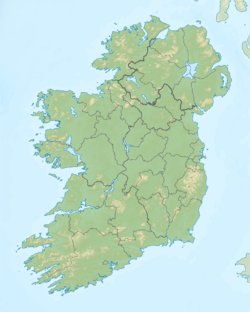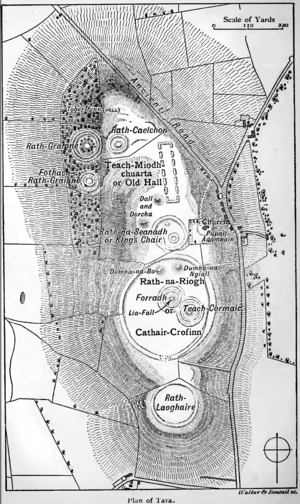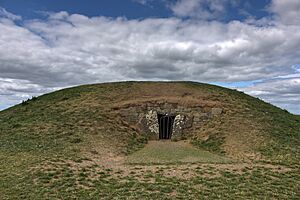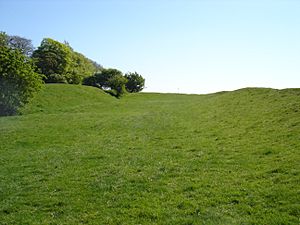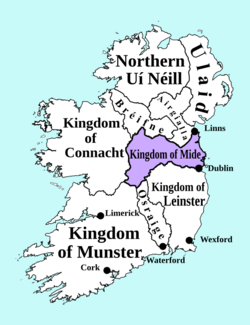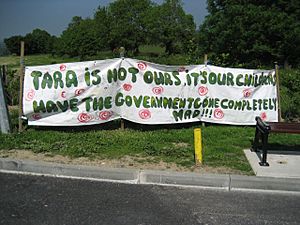Hill of Tara facts for kids
|
Teamhair
|
|
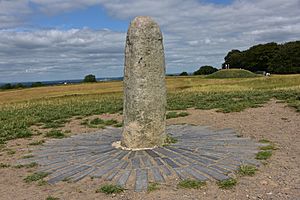
The Lia Fáil (Stone of Destiny) atop the Hill of Tara, with the Mound of the Hostages in the background
|
|
| Location | County Meath, Ireland |
|---|---|
| Coordinates | 53°34′39″N 6°36′43″W / 53.57750°N 6.61194°W |
| Altitude | 155 m (509 ft) |
| Type | Ceremonial and burial site |
| History | |
| Periods | Neolithic–Iron Age |
| Cultures | Gaelic |
| Site notes | |
| Ownership | Currently the Irish Government through the Office of Public Works |
| Management | The Office of Public Works |
| Official name | Hill of Tara |
| Reference no. | 676 |
The Hill of Tara (Irish: Teamhair or Cnoc na Teamhrach) is a famous hill in County Meath, Ireland. It is an ancient place where important ceremonies and burials happened long ago. Many people believe it was once the special place where the High Kings of Ireland were crowned and ruled.
Tara is also a big part of Irish mythology, appearing in many old stories. On the hill, you can find many ancient structures. These include old tombs, burial mounds, and large circular enclosures. Some of these date back to the Stone Age and Iron Age. One famous stone, the Lia Fáil (Stone of Destiny), is also there. Today, the Hill of Tara is a protected national monument. The Office of Public Works looks after it.
Contents
What's in a Name?
The name Tara comes from the Irish word Teamhair. It can also be called Cnoc na Teamhrach, which means 'hill of Tara'. Another old name for it was Teamhair na Rí, meaning 'Tara of the kings'.
Experts believe the name Teamhair might mean 'sanctuary' or 'sacred space'. This suggests it was a special place set aside for important ceremonies. Another idea is that it means "a high place with a great view."
Ancient Features and Early History
Exploring Ancient Monuments
You can see the remains of about twenty ancient monuments on the Hill of Tara. But surveys have found at least three times more hidden underground!
The oldest visible monument is the Dumha na nGiall, also known as the 'Mound of the Hostages'. This is a passage tomb, a type of ancient burial chamber. It was built around 3,200 BC, during the Stone Age. Inside, archaeologists found the remains of hundreds of people. Most of these were cremated bones.
For about 100 years, this mound was used as a shared tomb for a whole community. Later, in the Bronze Age, it was used again for about 33 more burials. During this time, only very important people were buried there. The last person buried was a young man with a fancy necklace and dagger.
Circular Structures and Burial Mounds
During the late Stone Age or early Bronze Age, a huge double timber circle was built on the hilltop. This was like a "wood henge" and was 250 meters wide. It surrounded the Mound of the Hostages. Several smaller burial mounds were also built around this timber circle. These include mounds known as Dall and Dorcha. Over time, the timber circle disappeared, and these smaller mounds are hard to see today.
Iron Age Enclosures
Several large round enclosures were built on the hill during the Iron Age. The biggest one is Ráth na Ríogh (the Enclosure of the Kings). It is about 1,000 meters around and has an inner ditch and outer bank. It was built around the 1st century BC.
Inside the Ráth na Ríogh are two more round enclosures. These are Teach Chormaic ('Cormac's House') and the Forradh or Royal Seat. On top of the Forradh is a standing stone. Many people believe this is the famous Lia Fáil ('Stone of Destiny'). Legend says this stone would roar when the true king of Ireland touched it.
Just north of the Enclosure of the Kings is Ráth na Seanadh (the 'Rath of the Synods'). This is another round enclosure with four rings of ditches and banks. It was used between the 1st and 4th centuries AD. Roman items were found here, showing connections with the Roman Empire.
Other round enclosures include Ráth Laoghaire ('Laoghaire's Fort') at the southern end of the hill. At the northwestern end are the Claonfhearta ('Sloping Trenches'). These are burial mounds on a slope.
At the northern end of the hill is Teach Miodhchuarta or 'Banqueting Hall'. This was likely a special path or avenue leading to the hilltop. It seems to have been one of the last monuments built.
Half a mile south of Tara is another large enclosure called Rath Meave. This name refers to the legendary figure Medb or Medb Lethderg.
The Church on the Hill
A church called Saint Patrick's is on the eastern side of the hilltop. The churchyard has partly damaged the "Rath of the Synods." The current church building was built in 1822–23. It stands where an older church once was.
Records show a church existed at Tara as early as the 1190s. Today, the church building is used as a visitor center. The Office of Public Works runs it.
The Five Roads of Tara
According to old legends, five ancient roads met at Tara. These roads linked Tara to all parts of Ireland. The earliest mention of these roads is in an old tale called Togail Bruidne Da Derga.
The five roads are said to be:
- Slighe Assail: This road went west towards Lough Owel and then to Rathcroghan.
- Slighe Midluachra: This road went to Slane, then to Navan Fort, and ended at Dunseverick.
- Slighe Cualann: This road passed through Dublin and towards Waterford.
- Slighe Dala: This road went towards and through Ossory.
- Slighe Mhór ('Great Highway'): This road generally followed the Esker Riada to County Galway.
Why Tara is Important
The entrance to the Mound of the Hostages faces the sunrise around the times of Samhain and Imbolc. Samhain is an old Gaelic festival marking the start of winter. Imbolc marks the start of spring. This shows how important the sun and seasons were to the people who built Tara. Old Irish writings tell us that a royal gathering called the 'feast of Tara' was held there at Samhain.
By the start of Ireland's recorded history, Tara had become the special place for crowning kings. Historians say Tara had a unique feeling that made it more important than other royal sites. It was known as the home of the High King of Ireland. Many important stories in early Irish literature are centered around Tara.
Irish legends say that the Lia Fáil (Stone of Destiny) was brought to Ireland by the magical Tuatha Dé Danann. It was said to cry out when the true king stepped on it. The goddess Medb Lethderg was linked to the kingship of Tara. Stories about High King Conaire Mór and Cormac mac Airt also show the importance of Tara's kingship.
Tara was likely controlled by different groups over time. In the 5th century, Niall of the Nine Hostages took control. After this, Tara became the ceremonial home of the Uí Néill family.
According to Irish mythology, a big battle called the Cath Gabhra happened in the 3rd century. It was fought between High King Cairbre Lifechair and the Fianna, led by Fionn Mac Cumhaill. The Fianna lost badly. Many of their graves, including that of Oscar, are said to be at the Rath of the Gabhra.
Later History of Tara
During the Irish Rebellion of 1798, Irish rebels set up a camp on the hill. British soldiers attacked them on May 26, 1798. The rebels were defeated. It is said that the Lia Fáil was moved to remember the 400 rebels who died there.
In 1843, a famous Irish leader named Daniel O'Connell held a huge peaceful protest at Tara. Over 750,000 people gathered to support Irish self-governance. This event showed how important Tara still was to the Irish people.
Around the year 1900, some people called British Israelists caused damage to Tara. They believed that the British were part of the Lost Tribes of Israel. They thought the Ark of the Covenant was buried on the hill. A group led by Edward Wheeler Bird started digging up the site. Many Irish cultural leaders, like Douglas Hyde and W. B. Yeats, protested this destruction.
The Irish government bought the southern part of the hill in 1952. They bought the northern part in 1972.
Motorway Development
A new motorway, the M3, was planned to pass through the Tara-Skryne Valley. This valley is very close to the Hill of Tara. People who protested argued that Tara is part of a much larger ancient landscape. They felt the motorway would harm this important historical area. The motorway passes about 2.2 kilometers (1.4 miles) from the hill.
In 2007, over 1,500 people gathered on the Hill of Tara to protest. They formed a human sculpture spelling out "SAVE TARA VALLEY." Famous actors like Stuart Townsend and Jonathan Rhys Meyers joined the event.
The Hill of Tara was added to the World Monuments Fund's list of the 100 Most Endangered Sites in 2008. The Smithsonian Institution also listed it as one of 15 must-see endangered cultural treasures. Despite the protests, the motorway project went ahead. The road opened in June 2010.
Images for kids
See also
 In Spanish: Colina de Tara para niños
In Spanish: Colina de Tara para niños


